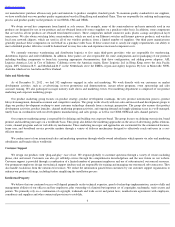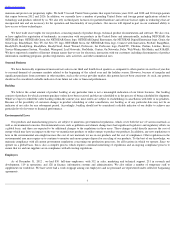Netgear 2012 Annual Report Download - page 20
Download and view the complete annual report
Please find page 20 of the 2012 Netgear annual report below. You can navigate through the pages in the report by either clicking on the pages listed below, or by using the keyword search tool below to find specific information within the annual report.
Table of Contents
The average selling prices of our products typically decrease rapidly over the sales cycle of the product, which may negatively affect our net
revenue and gross margins.
Our products typically experience price erosion, a fairly rapid reduction in the average unit selling prices over their respective sales cycles. In
order to sell products that have a falling average unit selling price and maintain margins at the same time, we need to continually reduce product and
manufacturing costs. To manage manufacturing costs, we must collaborate with our third-party manufacturers to engineer the most cost-
effective
design for our products. In addition, we must carefully manage the price paid for components used in our products. We must also successfully
manage our freight and inventory costs to reduce overall product costs. We also need to continually introduce new products with higher sales prices
and gross margins in order to maintain our overall gross margins. If we are unable to manage the cost of older products or successfully introduce new
products with higher gross margins, our net revenue and overall gross margin would likely decline.
We have been and will be investing increased additional in-
house resources on software research and development, which could disrupt our
ongoing business and present risks not originally contemplated.
We plan to continue to evolve our historically hardware-
centric business model towards a model that includes more sophisticated software
offerings. As such, we will further evolve the focus of our organization towards the delivery of more integrated hardware and software solutions for
our customers. While we have invested in software development in the past, we will be expending additional resources in this area in the future. Such
endeavors may involve significant risks and uncertainties, including distraction of management from current operations, insufficient revenue to offset
liabilities assumed and expenses associated with the strategy, inadequate return on capital, and unidentified issues not discovered in our due
diligence. Software development is inherently risky for a company such as ours with a historically hardware-
centric business model, and accordingly,
our efforts in software development may not be successful. Any increased investment in software research and development may materially
adversely affect our financial condition and operating results.
We may spend a proportionately greater amount on software research and development in the future. If we cannot proportionately decrease our
cost structure in response to competitive price pressures, our gross margin and, therefore, our profitability could be adversely affected. In addition, if
our software solutions, pricing and other factors are not sufficiently competitive, or if there is an adverse reaction to our product decisions, we may
lose market share in certain areas, which could adversely affect our revenue and prospects.
Software research and development is complex. We must make long-
term investments, develop or obtain appropriate intellectual property and
commit significant resources before knowing whether our predictions will accurately reflect customer demand for our products and services. We
must accurately forecast mixes of software solutions and configurations that meet customer requirements, and we may not succeed at doing so within
a given product's life cycle or at all. Any delay in the development, production or marketing of a new software solution could result in us not being
among the first to market, which could further harm our competitive position. In addition, our regular testing and quality control efforts may not be
effective in controlling or detecting all quality issues and defects. We may be unable to determine the cause, find an appropriate solution or offer a
temporary fix to address defects. Finding solutions to quality issues or defects can be expensive and may result in additional warranty, replacement
and other costs, adversely affecting our profits. If new or existing customers have difficulty with our software solutions or are dissatisfied with our
services, our operating margins could be adversely affected, and we could face possible claims if we fail to meet our customers' expectations. In
addition, quality issues can impair our relationships with new or existing customers and adversely affect our brand and reputation, which could
adversely affect our operating results.
As part of growing our business, we have made and expect to continue to make acquisitions. If we fail to successfully select, execute or
integrate our acquisitions, then our business and operating results could be harmed and our stock price could decline.
From time to time, we will undertake acquisitions to add new product lines and technologies, gain new sales channels or enter into new sales
territories. For example, we recently closed two acquisitions. First, in June 2012 we acquired select assets of a small engineering operation in India to
enhance our wireless product offerings in our commercial business unit. Additionally in July 2012, we closed the acquisition of privately held
AVAAK, Inc., creators of the VueZone®
home video monitoring system. In addition, in January 2013, we announced the acquisition of the AirCard
business of Sierra Wireless, Inc. Upon closing, the AirCard acquisition would represent our largest acquisition, both in terms of consideration and
headcount. Acquisitions involve numerous risks and challenges, including but not limited to the following:
16
•
integrating the companies, assets, systems, products, sales channels and personnel that we acquire;
•
growing or maintaining revenues to justify the purchase price and the increased expenses associated with acquisitions;
























